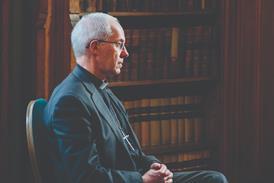With the most significant day in the Christian calendar approaching, Andy Witherall unveils five undeniable facts supporting Jesus’ resurrection

When asked his thoughts on Jesus’ resurrection, the atheist Richard Dawkins famously responded, “Accounts of Jesus’s resurrection and ascension are about as well-documented as Jack and the Beanstalk.”
Dawkins is in good company because Jesus’ followers took some convincing too! Thomas, for example, who was not present when Jesus appeared to the other disciples, said plainly, “Unless I see in his hands the mark of the nails, and place my finger into the mark of the nails, and place my hand into his side, I will never believe.” (John 20:25) Eight days later Thomas got his wish and fell to his knees in worship.
Many people will resonate with Thomas’ and Dawkins’ cynicism. Understandbly, the idea that someone has actually risen from the dead is a little hard to swallow. Yet, surprisingly many of the claims surrounding the Easter story are actually accepted by unbelieving Bible historians. The question is not whether these claims occurred but whether they prove the resurrection. Let’s consider two: the historical reality of the empty tomb and the disciple’s genuine belief in Jesus’ resurrection.
The historical reliability of the empty tomb
In Jesus The Jew: A Historian’s Reading Of The Gospels, Bible scholar and sceptic Géza Vermes writes, “When every argument has been considered and weighed, the only conclusion acceptable to the historian must be… that the women who set out to pay their last respects to Jesus found to their consternation, not a body, but an empty tomb.”
Let us look at three pieces of evidence for the empty tomb:
● The empty tomb is an early tradition
This fact is really important. Mark, our earliest source, is generally dated around 70 AD putting it within a generation of Jesus’ death. The creed which Paul quotes in 1 Corinthians 15:3-8 which implies an empty tomb, is dated to within five years of Jesus’ death. This allows for the possibility of eye-witness testimony and for the people to check for themselves.
● Jesus’ tomb was discovered by women
Again, this is significant. In Jesus’ culture the testimony of women was seen as invalid. If someone wanted to invent a story that would have been believed, using women would have been a very odd choice.
● No body was ever produced
The Jewish authorities were completely opposed to the early church. All they had to do was to produce the body and Christianity would never have got going. The fact that they never did is strong evidence that there was no body to produce.
What explanation fits the evidence?
Could there be another explanation for the empty tomb other than resurrection? Perhaps Jesus didn’t die at all but merely fainted and revived in the cool of the tomb. This explanation is hard to believe. After being scourged and crucified for six hours, can we believe that Jesus unloosed himself from his tight grave clothes, single-handedly rolled away the heavy boulder, defeated the armed soldiers and then went up and down the land showing himself alive? Such an explanation is untenable.
Others suggest grave robbery. Again this is problematic. The disciples did not expect the resurrection to occur and showed no notion of stealing the body. They would have had to defeat the entire armed guard. And what about the folded grave-clothes? Any robbery would have to have been a quick getaway. There would be no time for standing in the tomb, unwrapping the corpse and folding the clothes away!
Perhaps the women got the wrong tomb. Again this explanation fails for a number of reasons. The first is that Luke tells us that the women were present when Jesus was buried (Luke 23:55). The Jewish leaders certainly knew where the tomb was - they had set the guard in front of it and it belonged to one of their own - Joseph of Arimathea.
It is hard to find a convincing alternative explanation to the one the angel at the tomb gives: “He has risen!”
The disciples’ belief in the resurrection
In The New Testament: A Historical Introduction to the Early Christian Writings, the agnostic Bible scholar, Bart Ehrman, concedes “It is a historical fact that some of Jesus’ followers came to believe that he had been raised from the dead soon after his execution.” What evidence is there for such sincerity of belief? Let us consider two.
● The disciples’ lives were changed
The disciples went from cowards in hiding to bold proclaimers of the resurrection. But two people in particular stand out. The first was James - Jesus’ half brother. James was opposed to Jesus’ ministry when he was alive yet he ended up as the head of the church. Then there was Saul of Tarsus, who later became Paul. What could turn a person from seeking to kill worshippers of Jesus to becoming a Jesus-worshipper? Paul tells us it was a meeting with the risen Jesus himself (1 Corinthians 15:8).
● The disciples suffered and died for their belief in the resurrection
We know from history that many of the disciples suffered and died for their belief. In 2 Corinthians 11:24-27 Paul gives a list of his own sufferings which included scourgings, shipwrecks, imprisonment and exposure to the elements. The first century historian Clement lists Paul, and Peter, as examples of those who were persecuted “even unto death.” (1 Clement 5:1-7) Another historian, Josephus, records for us the stoning of James (Antiquities 20.9.1). As the saying goes, “Liars make bad martyrs.”
What explanation fits the evidence?
Again, perhaps there is another explanation other than resurrection. Perhaps the disciples had visions brought on by grief or guilt. But that is difficult to square with what the Bible tells us. Hallucinations are private and subjective. But these were often group experiences - as when Jesus appealed to the Twelve or when 500 saw him at the same time. Furthermore, visions are not physical. But Thomas placed his fingers in Jesus’ scars. Jesus cooked a fish breakfast for his disciples at the beach. It does not follow that the information we have on the resurrection appearances are consistent with mere hallucinations. Once more, the Bible gives its own answer: “Christ is risen!”
We have considered, with broad brush strokes, two facts that many sceptical Bible scholars accept. Time and again we see that alternative explanations don’t add up. Perhaps you are a sceptic, wary of the idea of resurrection. Maybe you’re not sure what you think of it all at the moment. The historical evidence gives much food for thought. Why not take a deeper look into it yourself this Easter?





































No comments yet